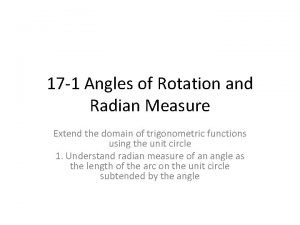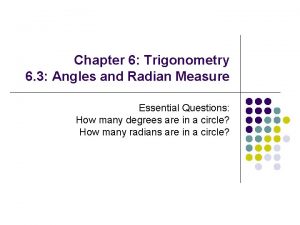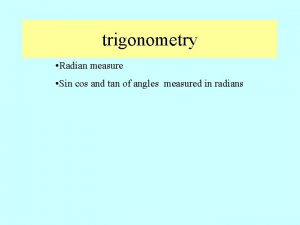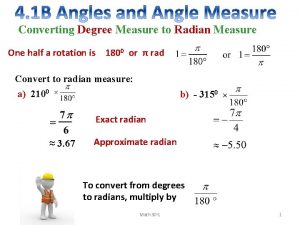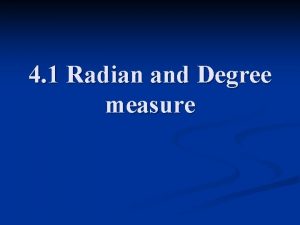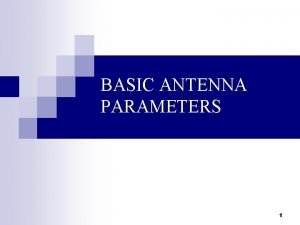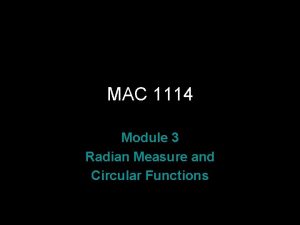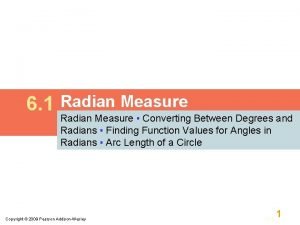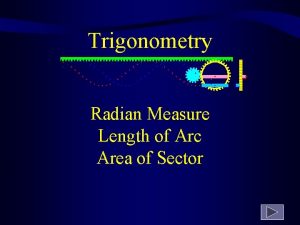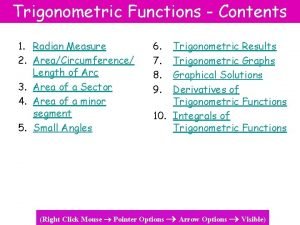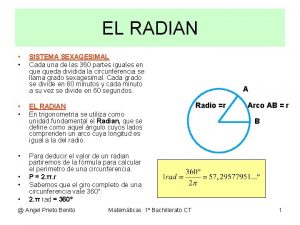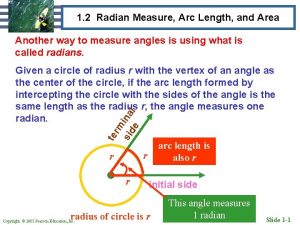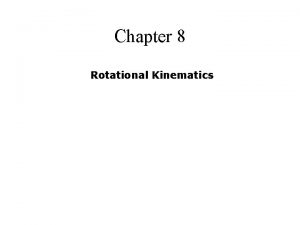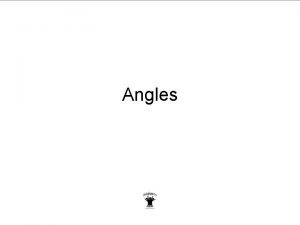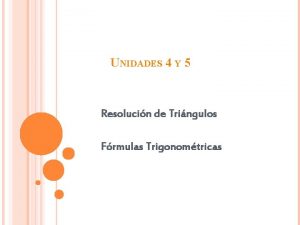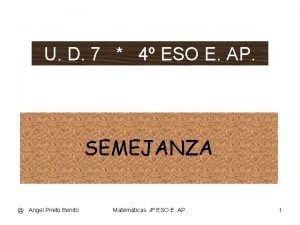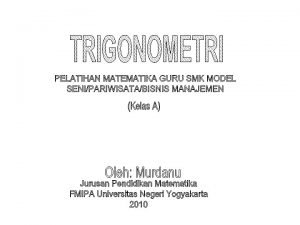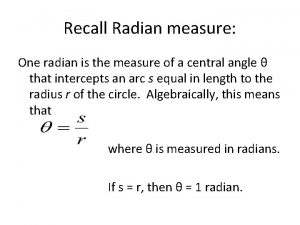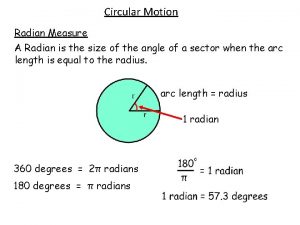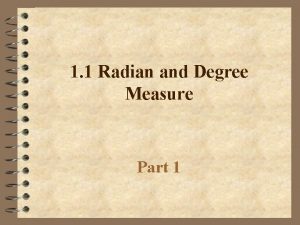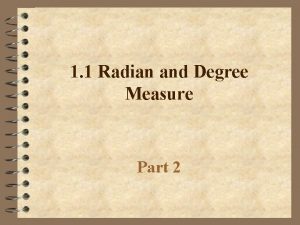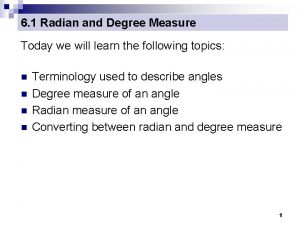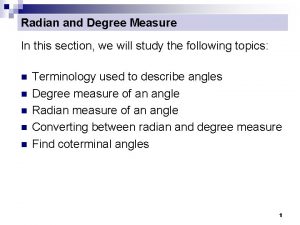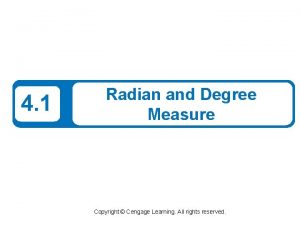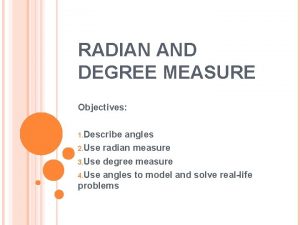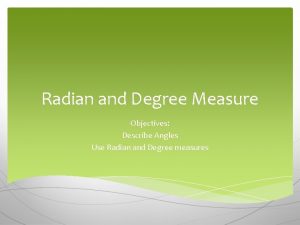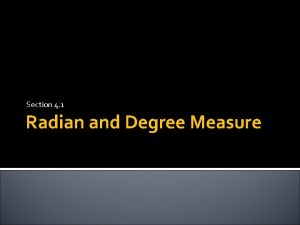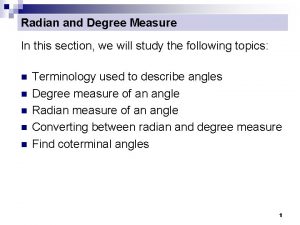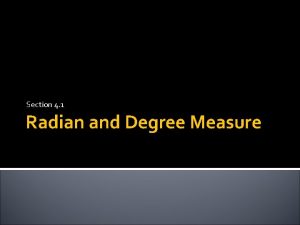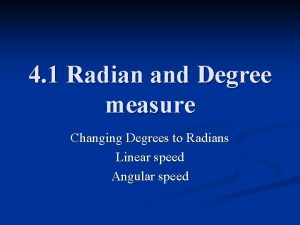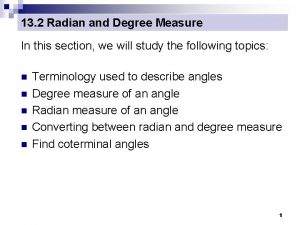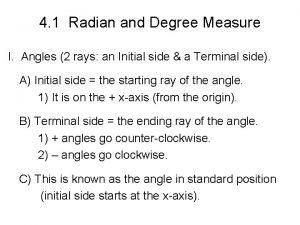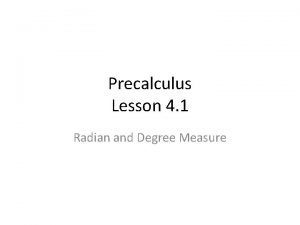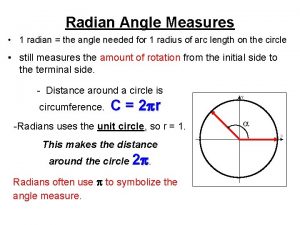1 1 Radian and Degree Measure Part 1
























- Slides: 24

1. 1 Radian and Degree Measure Part 1

Objectives: Students will be able to sketch angles in standard position and determine whether an angle is positive or negative. Students will understand what a radian measure is and how it is used to measure angles. Given an angle, students will be able to find coterminal angles, complementary angles, and supplementary angles.

Radians and Angles Welcome to Trigonometry!! Starring Angles The Coterminal Angles Radian Supp & Comp Angles Degree The Converter And introducing…

THE UNIT CIRCLE You & I are gonna be great friends!

What is Trigonometry? Ø The word Trigonometry literally means “measurement of triangles. ” Ø The relationships among the sides and angles of triangles are used in surveying, navigation, and astronomy. Ø Trigonometric relationships are also functions that apply to physical phenomena such as sound waves, light rays, vibrating strings, pendulums, planetary orbits and orbits of atomic particles

What is an ANGLE in Trigonometry? Ø An angle is formed by rotating a half-line, called a ray, around its end point. Ø One ray is fixed, and is called the initial side. Ø The second ray is called the terminal side. Ø The common end point is called the vertex. Vertex q

ANGLES on a Coordinate System Ø STANDARD POSITION: Ø The Vertex is placed at the Origin Ø The Initial side is always the positive X-axis. Y Vertex q X

Positive, Negative & Coterminal Angles Ø A positive angle results from a counter -clockwise rotation. Ø A negative angle results from a clockwise rotation. + 135 º -225 º Two angles with the same initial and terminal side are coterminal. So + 135 º and - 225 º are coterminal!

Labeling Angles: Greek Letters: Uppercase Letters α (alpha) A β (beta) B θ (theta) C

DEFINITION: Measure of an Angle Amount of rotation from the initial side to the terminal side. Vertex q

©Carolyn C. Wheater, 2000 Radian Measure One way to measure an angle is in radians. This type of measure is useful in Calculus. A radian is the measure of a central angle θ whose intercepted arc s is equal in length to the radius r of the circle. s=r r q r

Calculate the number of radians in one full circle: **Circumference is: **A central angle of one full revolution corresponds to an arc length of: **The radian measure of a central angle: **Therefore, the number of radians in one full circle is:

Now, we can obtain the following: ½ revolution = = π radians ¼ revolution = radians 1/6 = 3. 14 0, 2 0, 6. 28

Common Radian Angles:

Quadrants in a Coordinate plane: There are 4 Quadrants Quadrant III Quadrant IV

Which angles between 0 and 2π lie in each of the 4 Quadrants? ? ? θ = π/2 Quadrant II π/2 < θ < π Quadrant I 0 < θ < π/2 θ=π θ = 0, 2π Quadrant III π < θ < 3π/2 Quadrant IV 3π/2 < θ < 2π θ = 3π/2

***Note*** The phrase “the terminal side of θ lies in a quadrant” is often shortened by saying “θ lies in a quadrant. ” The terminal sides of “quadrantal angles” 0, π/2, π, and 3π/2 do NOT lie inside the quadrants. θ = π/2 Quadrant II π/2 < θ < π Quadrant I 0 < θ < π/2 θ=π θ = 0, 2π Quadrant III π < θ < 3π/2 Quadrant IV 3π/2 < θ < 2π θ = 3π/2

Right, Acute, and Obtuse Angles π/2 is a right angle q 0 < q < π/2 is an acute angle q π/2 < q < π is an obtuse angle

Coterminal angles have the same initial and terminal side: π/6, 13π/6 0, 2π 0 and 2π are coterminal π/6 and 13π/6 are coterminal A given angle has MANY coterminal angles!!! An angle coterminal with a given angle can be found by adding or subtracting multiples of 2π (one revolution). Example: θ = π/6 is coterminal with π/6 + 2 nπ, where n is an integer

Finding the coterminal angle: Find 2 coterminal angles to These are just two possible answers. Remember…there are more!

Types of angles Complementary Angles : Angles that add up to 90ᵒ or β+α= Supplementary Angles: Angles that add up to 180ᵒ or π X+Y=π

Find the Complement of The two angles must have a sum of Find the Supplement of The two angles must have a sum of π

Note: Sometimes an angle DOES NOT have a complement or supplement: Example: 4π/5 does not have a complement. Why not? Because it is greater than π/2

Classwork/Homework Finish Worksheet On Radian and Degree Measure Pg 123 -124 2 -38 (mult of 2) (eliminate 8, 10, 14, 20)
 Angles of rotation and radian measure
Angles of rotation and radian measure Vertical angles
Vertical angles Rad sin cos tan
Rad sin cos tan Convert from degrees to radians 67 degrees
Convert from degrees to radians 67 degrees Radian vs degree
Radian vs degree Measures air temperature
Measures air temperature Radian and steradian in antenna
Radian and steradian in antenna Gibbons jacobean city comedy download
Gibbons jacobean city comedy download Convert each degree measure into radians
Convert each degree measure into radians S=rθ
S=rθ Is hcn polar or nonpolar covalent bond
Is hcn polar or nonpolar covalent bond Minor arc length
Minor arc length Derivative of sin cos tan
Derivative of sin cos tan Contoh soal radian ke sentisimal
Contoh soal radian ke sentisimal Rad trigonometria
Rad trigonometria 2radian
2radian Contoh soal ukuran sudut dan konsep dasar sudut
Contoh soal ukuran sudut dan konsep dasar sudut Unit of angular acceleration
Unit of angular acceleration Vertex arm
Vertex arm Fórmulas de mru
Fórmulas de mru Pengertian ukuran sudut
Pengertian ukuran sudut đổi radian sang độ trong excel
đổi radian sang độ trong excel Radianes a grados
Radianes a grados Que es un radian
Que es un radian Rumus sudut lancip
Rumus sudut lancip
